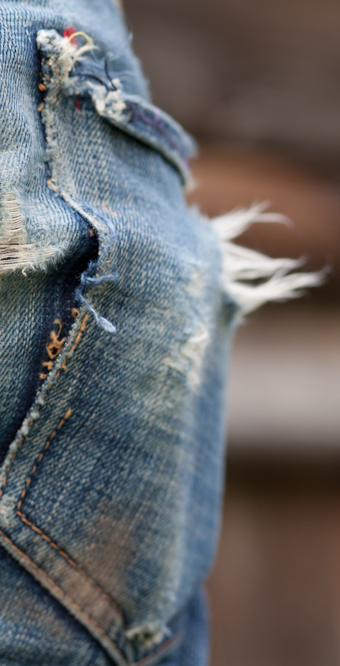GLOSSARY
KEY TERMS FOR BETTER UNDERSTANDING
Raw Denim
Raw denim, also known as dry or unwashed denim, is denim that has not undergone any of the usual washing and distressing processes. It is stiff with a deep blue color and has a distinctive sheen. Throughout their lifecycle, the denim will lose dye in areas specific to their wearer, leaving their owner with a one-of-a-kind fit and finish.
Regardless of your lifestyle, your jeans become a log of months gone by.
Crocking
Crocking occurs in heavily dyed fabric, such as raw denim. Compared to "bleeding", where the dye comes into contact with liquid; crocking occurs when the dye is physically rubbed off.
Crocking is one of the processes that gives raw denim its personality and is the cause for fades and atari on creases, seams, and any other worn areas.
Atari
A Japanese term for the selective fading of the ridges of creases. The most common areas for Atari are along the side seams, on the front and back of the knees, the upper thigh, along the hem, and on belt loops and along the pocket seams.
Whiskering
Whiskering is a term for the selective fading of the ridges of creases. The Japanese refer to this as "Hige", which literally translates to "moustache" in English. It is most commonly found in areas prone to creasing, like behind the knees or across the lap.
On pre-worn jeans, these fade marks are produced by scrubbing the jeans over boards with engraved patterns. However, these marks are not customized to your body, and as a result don't look as natural as the ones you form yourself!
Honeycombs
Honeycombs are the name used for the name of the visible folding behind the knees because of their cell-like structure. These will naturally occur in most jeans.
In commercial applications, the jeans are put on a mannequin and sanded. These are easy to spot, as they rarely line up with your natural contours.
Vertical Falling
A term for the streaky vertical fades in worn denim. It is a translation of the Japanese word "Tate-ochi". It is most prevalent in Slub denim, which has a bumpy surface. The Pure Blue Japan XX-005 are a great example of Slub.
Indigo
The dye used to give denim its blue color. Traditionally, indigo dye was taken naturally from plants but presently the dye is produced synthetically. Since the beginning of the twentieth century, the majority of manufactures use synthetic indigo dye, which is cheaper, stronger, and more predictable than natural indigo.
Selvedge
Initially known as 'self-edge', the selvedge is the narrow, tightly woven band on both edges of the denim fabric. A selvedge end prevents the edge of the denim from unraveling and shows a clean, finished look. Old shuttle looms produce denim where selvedges are closed. Alternatively, on larger modern weaving machines, the horizontal, or weft yarn is cut on every pick, resulting in a fringed edge.
The terms selvage and selvedge are a corruption of "self-edge", and have been in use since the 16th century
